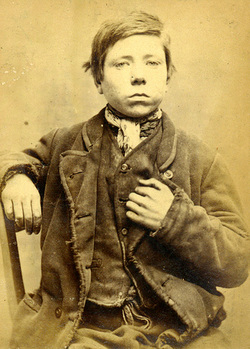
James Donneley
Also know as James Darley, at the age of just 16, this young man had been in and out of prison, but on this occasion he was sentenced for 2 months for stealing some shirts.
Age:16
Height:5.0
Hair: Brown
Eyes:Hazel
Place of Birth: Shotley Bridge
Work: Labourer
[Courtesy - Tyne & Wear Archives & Museums]
A couple of weeks ago, a friend sent me the link to a collection of photos on Flickr that fascinated me.
A museum and archive in Newcastle, England had just posted part of its collection on Flickr - fascinating photos of historic Newcastle. Among them was a collection of photographs of criminals taken in the early 1870s. I spent several days poring over the 75 or so photos and their accompanying descriptions.
I have been looking for an engaging, end-of-the-year activity for one of my 7th grade classes, so I spent a class period sharing the Victorian Mugshot Collection with them. They too, were fascinated. They had many questions:
- Why were the punishments so harsh for such minor crimes?
- Why were so many of the criminals so young?
- Why was everyone so tiny? (several of the criminals were 4'2" - the same size as my six year-old son)
- Why did the teenagers look so young?
- Why did the adults look so old?
- Why would anyone want to steal things like boots, bed linens and clothing?
- Why was this guy convicted of "obtaining oats under false pretenses"? What does that even mean?
- All these people seem to be very poor; would people from higher social classes have been treated as harshly?
We contacted the museum - through their website and through FlickrMail and asked if there was a historian on staff who could answer our questions. My students made a short video asking their questions. I sent the museum a link to the video (as well as including the questions in my emails, just in case there was some sort of glitch with the video).
Victorian Prisoners from John Fladd on Vimeo.
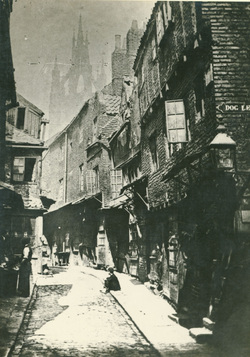
Somewhere in one of my emails, I had mentioned that it would be super-cool if we could video-conference with their historian via Skype. The museum was really excited by that idea and got back to me immediately to set up a time that worked with both our respective time-zones.
Here's the short version of that:
We had a great conversation with their historian, who answered most of our questions, but because I was suddenly overcome by a giant, tsunami-sized wave of incompetence, I didn't successfully record the conversation, so you'll have to use your imagination.
Our historian did forward several excellent photographs however, including this one of the neighborhood in Newcastle where most of our felons had lived.
[Oh, by the way. The answers to most of the questions boiled down to:
- Malnutrition
- Poverty
- More malnutrition
- Victorian ideas about crime and punishment
- Even more malnutrition and poverty]
Phase II
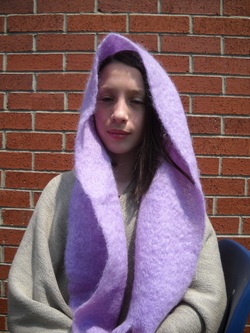
I bought a tattered tweed sports coat, a shawl and an acrylic scarf at a thrift store for about six dollars and a joke beard and a collection of mustaches from a party-goods store.
I took my 7th graders outside and photographed them in front of a brick wall.
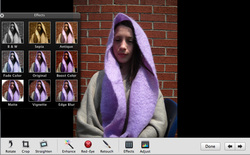
I played around with the photos in iPhoto (though this would probably work just as well with any photo-editing software). I converted the photo from color to sepia-toned.
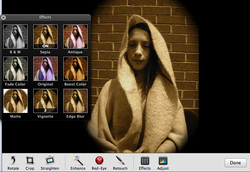
Then I used the "Vignette" setting to blur the corners and edges of the photo.
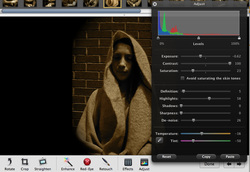
And then I played around with some of the other settings to make it look grainier and older.
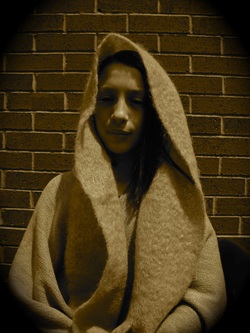
When I was done, I exported each picture to my computer desktop, using the lowest-quality settings possible. (For our purposes, the lower the quality of the photo, the more authentically Victorian it will look.)
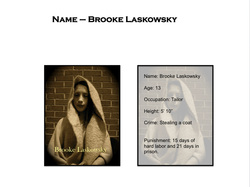
After thinking about what would be the fastest and easiest way to make the trading cards, I decided to use PowerPoint.
I created a slide with two blank boxes the same size as a traditional trading card (2.5"X3.5"). I put a bulleted list of the information I wanted on the second box, which would eventually be the backside of the trading card. I saved the slide as a template.
Next, I had the students access the template and format the background of the two boxes with their portrait. (Putting the picture in this way prevents some of the sizing issues that come with cutting and pasting or inserting it. It also makes it easier to write over.) They filled out the information in the "backside box" consistent with the information they had gotten from our historian in England.
We printed the slides and each student carefully cut out his or her boxes, then glued the two sides together. I laminated each card to make it more durable.
Pitfalls and Surprise Discoveries
1) If you don't allow the glue to dry completely (which takes several days) there is a weird chemical reaction between the glue, the printer ink and the heat from the laminator, which discolors the ink in splotches. This actually worked pretty well for this particular project - the splotches looked like sun damage and added an aged look to the pictures - but I think I'd avoid it in the future by not using any glue at all and just very carefully inserting the two halves of the trading card into the laminator dry.
2) When the large sheet of trading cards comes out of the laminator, you need to be careful to leave 1/16" or so of plastic around the edges to keep the paper from separating. This makes it look more like a trading card anyway; it's just something to keep in mind.
Other Applications of the Trading Card Idea
I've been giving this a lot of thought and I'm seeing a lot of potential applications for this process:
1) Science - Trading cards of chemical elements, classes of invertebrates or alternative energy sources.
2) Literacy/English - Trading cards of the various characters in group-read books. To Kill a Mockingbird comes to mind.
3) Art/Music - Trading cards of famous composers or artists and their pieces.
4) Geometry - Trading cards of different shapes, planes or figures
5) 4th Grade - The biggest project our 4th graders do during the year are Biographies of famous people. Trading cards would fit in very well with that.
Overall, I'm very pleased with this project for a first-time-through "beta-run". I'm wondering if changing the 7th grade curriculum to include a unit on Victorian History would be worthwhile. There would certainly be great Literacy and Science tie-ins.
Time will tell.
Instructions for Formatting the Boxes in PowerPoint:
| trading_cards.doc |
| victorian_prison.doc |
 RSS Feed
RSS Feed